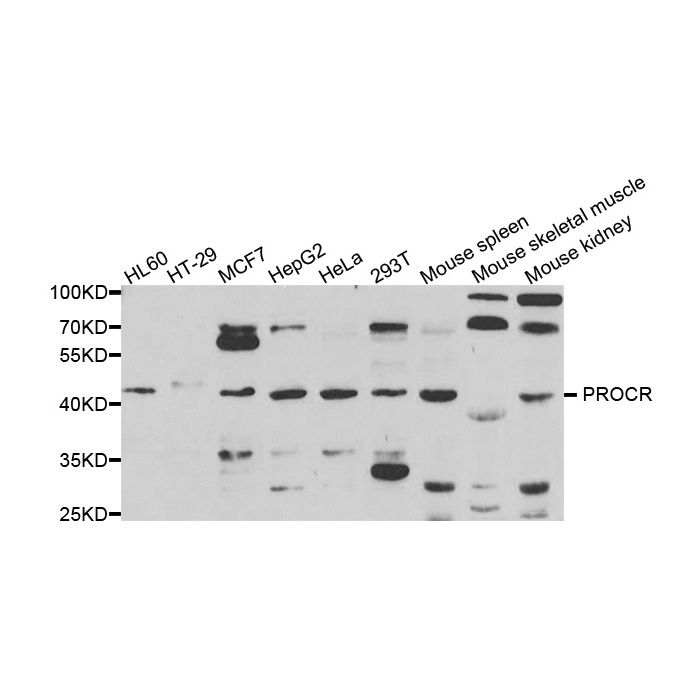CD201 (PROCR) polyclonal, anti-human, mouse, rat
€388.00
In stock
SKU
BS7843
Background:
Thrombomodulin (TM) is an endothelial specific receptor that forms a complex with Thrombin, a protein with procoagulant, inflammatory and anticoagu-lant effects. The TM/Thrombin complex activates Protein C (PC) to generate activated Protein C (APC) and initiate the APC anticoagulant pathway. APC attenuates Thrombin formation through the inactivation, by limited proteolysis, of two significant cofactors of blood clot formation, Factor Va and Factor VIIIa. This process is augmented by the activity of the endothelial cell Protein C receptor (EPCR), which binds both PC and APC with high affinity. The EPCR gene maps to human chromosome 20q11.2 and encodes an anticoagulant that is preferentially expressed on large blood vessel endothelium in the heart and lung with some expression in capillaries in the lung and skin. EPCR, also designated CCD41 in mouse, is a member of the major histocompatibility complex and displays significant homology to CD1. Soluble plasma EPCR is thought to inhibit the membrane-bound EPCR activation of the APC pathway.
Alternative Name:
Activated protein C receptor, APC receptor, APCR, bA42O4.2, CCCA, CCD41, CD201, CD201 antigen, cell cycle, centrosome-associated protein, Cell cycle, centrosome-associated protein, centrocyclin, Endothelial cell protein C receptor, Endothelial protein C receptor, EPCR, EPCR_HUMAN, MGC23024, PROCR, Protein C receptor, endothelial,
Application Dilution: WB: 1:500~1:2000, IHC: 1:50~1:200
Specificity: PROCR polyclonal antibody detects endogenous levels of PROCR protein.
Immunogen:
Recombinant full length Human PROCR.
MW: ~ 52 kDa
Swis Prot.: Q9UNN8
Purification & Purity:
The antibody was affinity-purified from rabbit antiserum by affinity-chromatography using epitope-specific immunogen and the purity is > 95% (by SDS-PAGE).
Format:
1mg/ml in PBS with 0.1% Sodium Azide, 50% Glycerol.
Storage:
Store at 4°C short term. Aliquot and store at -20°C long term. Avoid freeze-thaw cycles.
For research use only, not for use in diagnostic procedure.
Thrombomodulin (TM) is an endothelial specific receptor that forms a complex with Thrombin, a protein with procoagulant, inflammatory and anticoagu-lant effects. The TM/Thrombin complex activates Protein C (PC) to generate activated Protein C (APC) and initiate the APC anticoagulant pathway. APC attenuates Thrombin formation through the inactivation, by limited proteolysis, of two significant cofactors of blood clot formation, Factor Va and Factor VIIIa. This process is augmented by the activity of the endothelial cell Protein C receptor (EPCR), which binds both PC and APC with high affinity. The EPCR gene maps to human chromosome 20q11.2 and encodes an anticoagulant that is preferentially expressed on large blood vessel endothelium in the heart and lung with some expression in capillaries in the lung and skin. EPCR, also designated CCD41 in mouse, is a member of the major histocompatibility complex and displays significant homology to CD1. Soluble plasma EPCR is thought to inhibit the membrane-bound EPCR activation of the APC pathway.
Alternative Name:
Activated protein C receptor, APC receptor, APCR, bA42O4.2, CCCA, CCD41, CD201, CD201 antigen, cell cycle, centrosome-associated protein, Cell cycle, centrosome-associated protein, centrocyclin, Endothelial cell protein C receptor, Endothelial protein C receptor, EPCR, EPCR_HUMAN, MGC23024, PROCR, Protein C receptor, endothelial,
Application Dilution: WB: 1:500~1:2000, IHC: 1:50~1:200
Specificity: PROCR polyclonal antibody detects endogenous levels of PROCR protein.
Immunogen:
Recombinant full length Human PROCR.
MW: ~ 52 kDa
Swis Prot.: Q9UNN8
Purification & Purity:
The antibody was affinity-purified from rabbit antiserum by affinity-chromatography using epitope-specific immunogen and the purity is > 95% (by SDS-PAGE).
Format:
1mg/ml in PBS with 0.1% Sodium Azide, 50% Glycerol.
Storage:
Store at 4°C short term. Aliquot and store at -20°C long term. Avoid freeze-thaw cycles.
For research use only, not for use in diagnostic procedure.
| Is Featured? | No |
|---|
Write Your Own Review

